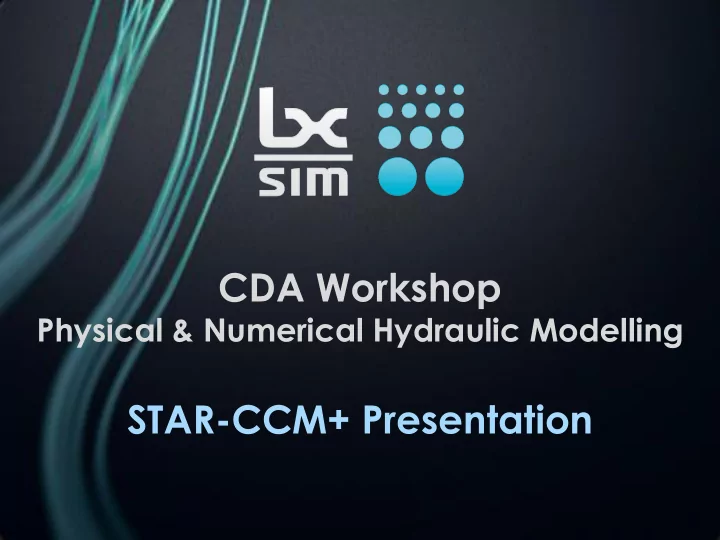

CDA Workshop Physical & Numerical Hydraulic Modelling STAR-CCM+ Presentation
CFD ENGINEERING FEA SIMULATION
Mission Increase the competitiveness of companies through optimization of their product development using engineering simulation.
Lx Sim Services – Engineering Simulation Outsourcing – CAE-Intensive Product Design – Training 4
Softwares • CFD • Optimization/DOE – STAR-CCM+ • OptiStruct – AcuSolve • HyperStudy • FEA • Process – HyperMesh/RADIOSS • HyperForm – HyperCrash • HyperXtrude – DesignLife • Moldex 3D • MBD • Post-Processing – MotionSolve • FieldView (CFD) 5
Sample Projects • DFBI - CFD • Trim and Drag Prediction on Ship Hull 6
Sample Projects • Non-Linear FEA • Prediction of Plastic Deformations on Frame 7
Sample Projects • Heat Transfer / Solar Radiation / Porous Baffle – CFD Automation of Solar Air Heater CFD • 8
Outline • STAR-CCM+ Overview and Capabilities • Modeling and simulation procedure • Limitations and known problems • Case Study • Questions 9
STAR-CCM+ Overview & Capabilities • CD-adapco is the largest privately owned CFD company • STAR-CCM+ GUI is java based, code is C++ – Very flexible – Customization possible – Java macro system • Finite volume method 10
STAR-CCM+ Overview & Capabilities • General purpose CFD – Multi-Physics • CAD package • Multiple meshing approaches • Included post-processing • Optimization 11
Complete Solution from CAD to Post 12
GUI Presentation • Tree-based management • Graphical window • Output • Properties 13
Tree-Based Management 14
CAD Preparation 3D-CAD • – Creating or modifying geometries – Similar to any sketch based package – Somewhat limited – Exposing design variables Operation History • – Boolean – Meshes – Adds repeatability 15
Wrapper and Surface Repair Before After 16
Meshers Trimmed cell • Polyhedral • – Embedded thin Tetrahedral • Prism • Thin mesher • Refinement • – Volume – Surfaces – Edges 17
Physics – Electrochemistry – Multiphase – Electromagnetism • Lagrangian – Overset meshes • Eulerian – Radiation • VOF – Aeroacoustics • DEM – Batteries – Conjugated heat transfer – Casting – Shell modeling – DFBI – Chemistry – FSI • Combustion • Solid stress • DARS • Direct coupling – Optimization solver – Adjoint solver 18
DAM Related Models • VOF for multiphase - Cavitation - Particle transport and interaction DEM - Erosion model • Moving parts, rotation, translation • Multiple meshes approach 19
Cons • No aeration by default or custom - Surface data not accessible during calculations • Babysitting necessary – Tweaking of interface solvers – Mesh dependency - Large mesh - Long transient analysis 20
Case Study – Modelling Method 21
Geometry Preparation • Create top boundaries • Operations to split in 3 regions – Inlet – Spillway – Outlet 22
Meshing • Trimmed cells – Known surface – Fast • Mesh alignment • Y+ between 10 and 150 targeted • Refinement for interface • Final mesh: – Convergence not fully obtained – Constraint in time and CPUs • Use of relative to base size values 23
Mesh - 0.52Hd - 2.7M Base size at 15m • Medium transition in • volume Surface • 0.375m in inlet and • outlet regions 0.15 m in spillway • 24
Mesh - 0.52Hd - 4.4 M Base size at 15m • Medium transition in • volume Surface • 0.375m in inlet and • outlet regions 0.15 m in spillway • 25
Physics Model • VOF multiphase • Turbulent – All y+ treatment • Transient analysis • Use of VOF wave to specify reservoir levels and inlets 26
Initial Conditions 27
Boundary Conditions Pressure VOFWave 28
Solver Set-Up and Convergence Multiple mesh approach to save computation time • Time step 0.01s to 0.05s • – Settings available to increase accuracy for C >1 – Stability issue 5 iterations per time step • Presence of oscillations in solution flow rate • – Potential mesh vs timestep problem – Choice made for time constraints vs accuracy 29
Case Study 1.5 X Design Head • Q = 601 m 3 /s • Maximum elevation at 224.2 m 30
Velocity 31
Velocity 32
Relative Pressure 33
Relative Pressure 34
Froude Number 35
Turbulent Kinetic Energy Generating Air Entrainment 36
Air Entrainment at Surface Only • Creation of field functions to find location air entrainment • Exportation of the approximate surface • Importation of the surface as a fluid region • Interpolate functions on it • Calculate aeration • Attempted transport without success 37
Air Entrainment at Surface Only 38
Case Study 0.52 X Design Head • Q = 115 m 3 /s 39
Velocity 40
Velocity 41
Relative Pressure 42
Relative Pressure 43
Froude Number 44
Turbulent Kinetic Energy Generating Air Entrainment 45
Air Entrainment at Surface Only 46
Questions?
Wrong BC??
Recommend
More recommend